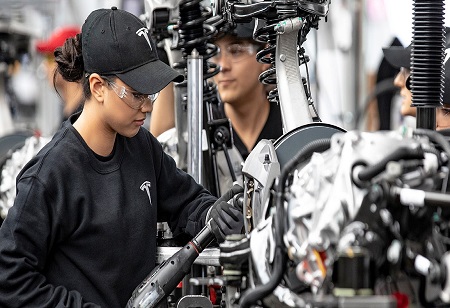Under Prime Minister Narendra Modi’s leadership, Indian manufacturing operations would become one of the world’s most robust as in the same year Modi officially launched “Make In India,” a government initiative that encouraged companies from parts of the globe to develop, produce, and assemble products in India with sizeable investments into manufacturing.
Five years after the initiative began, India’s manufacturing GDP was the lowest it had been in twenty years and dropped 1.2% in the first five years following the launch of Make In India. Now seven-and-a-half years later, Make in India is still a work in progress.
The General Motors brought a $1 billion investment to a manufacturing facility in Maharashtra, the city where Tesla has been rumored to land with a potential factory of its own while Kia invested $1.1 billion in 2017 and has been producing vehicles at its factory in the Anantapur District since January 2019. While the automation industry is growing in India, but still less than 1% of the country’s cars are electric.
Because of the extensive and massive $27 billion budget that has been set aside for these programs, India has tried to convince companies to bring manufacturing to the country directly.
A confusion sets to begin in - Why is Tesla, a company with a reputation for building the world’s best electric vehicles, that could likely build a manufacturing facility anywhere in the world, having so much trouble landing a deal in India to manufacture its vehicles?
The disconnect seems to be between Tesla’s requests and India’s needs. When Elon Musk, Tesla’s CEO, tweeted last night that there were still “challenges” when working with the Indian government, this had put the plans on hold once again, it seemed that the automaker’s requests for
import duty reductions went to the wayside. “If they have to manufacture here, they need the numbers, and no one can test the market when you impose such high import duty on the vehicles,” Union Road Transport Minister Nitin Gadkari said.
If import taxation was not an issue, Tesla could use data already available to them to determine whether a Gigafactory would make sense in India.
Currently, Tesla has no vehicles in its lineup that are under the $40,000 price threshold. The problem is those import duties is a big issue as India seems at least for now, even though the massive $27 billion budget would not be directly affected by an import tax rollback. In fact, that budget could still factor in tax losses from duty reductions. Perhaps the reasons associated to Tesla’s delayed entrance into India could be linked to the automaker’s lack of need for other companies due to its vertical integration and the President of the Automotive Component Manufacturers Association (ACMA) said that localization is always a priority, and companies entering the market need to promote local manufacturing across the board, not just with the final product.
This would include everything from complex factors like semiconductors to other elements that are as simple as car seats. Tesla makes many of its parts in-house, including some microcontrollers and its automotive seats. “Tesla is absurdly vertically integrated compared to other auto companies or basically almost any company. We have a massive amount of internal manufacturing technology that we built ourselves,” Musk said. “This makes it quite difficult to copy Tesla, which we’re not actually all that opposed to people copying us because you can’t do catalog engineering. You can’t just [say] I’ll pick up the supplier catalog, I’ll get one of those.”
This leaves India at a crossroads because while Tesla would be a great benefit to the economy, manufacturing efforts, and employment, the company would not have as much to offer other sectors and companies as an automaker.
After launching Gigafactory Shanghai in China in early 2020, the factory has become Tesla’s biggest producer of EVs and accounted for nearly 52% of the automaker’s total deliveries for 2021.
Therefore, Despite the company’s vertical integration, which has increased gross margin on some Made-in-China Tesla vehicles to nearly 40%, the company has provided China with many economic benefits and the site will soon employ 9,000 people on the Model Y line.
Gigafactory Shanghai will have 18,000 employees by the time the line expansion is completed and it will help encourage the adoption of EVs in Europe through exports, making the Model 3 the best-selling EV on the continent in 2021, with over 109,670 units sold.
However, Tesla has been a potential entrance for seven years ever since Modi visited the Fremont factory in 2015, this long saga of Tesla and India will continue for now.
